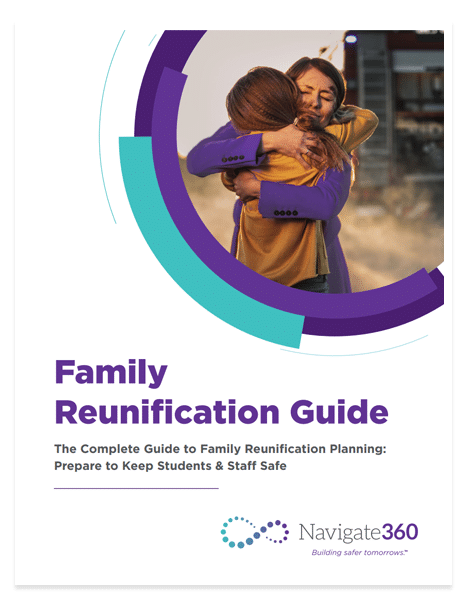What is Family Reunification?
Family reunification is the process of bringing together displaced students with their caregivers. While most often associated with active shooter scenarios, family reunification is a critical protocol for any situation where a school building is rendered unsafe. A well-orchestrated notification center & rehearsed family reunification plan can ease stress and potential mental health trauma experienced when family reunification procedures must be implemented by a school.
The Complete Guide to Family Reunification
One important aspect of a school's emergency response is its ability to reunify students with caregivers. This process is critical, as schools are accountable for maintaining the chain of custody for every student during and after an incident. Effective reunification also helps with the re-establishment of a social support system.
Navigate360's Family Reunification Guide provides a standard method districts and schools can apply to provide safety teams with processes for planning, practicing and achieving successful reunification.
Improve Family Reunification Planning by Going Beyond the Basics to Establish Notification Centers
Families and communities throughout our nation expect schools to provide a safe and secure learning environment where students and staff can thrive, and that requires comprehensive emergency operation planning. In collaboration with first responders, schools must create plans that include procedures for notification centers that will expediate family reunification for students and staff in the event a school is closed or unexpectedly evacuated due to a man-made emergency or a hazardous situation.
What is a Notification Center?
A notification center is a secure facility in a centralized location that provides information about injured, missing, unaccounted for or deceased persons and initial services for victims, family members and designated points of contact. The notification center also helps displaced survivors, including children, to re-establish contact or be reunited with their family and friends after a period of separation. The notification center is not intended for the general public, media or unaffiliated individuals.

What Do Parents Need to Know About Reunification?
Lessons learned from school emergencies demonstrate that educating parents in advance on what to expect during family reunification can foster a smooth process during a highly stressful time. By having plans in place to keep students and staff safe, schools play a critical role in taking preventative and protective measures to stop an emergency from occurring or reducing the impact of an incident.
FREE Parent Flyer
10 Things Parents Need to Know About Family Reunification
Navigate360 Offers Holistic Solutions that Support Students, Schools & Communities
We believe every child should be able to experience a school day without fear, so we strive for zero incidents—doing anything less is simply not an option!
We know it takes more than a single solution to take care of the whole child and the school community, which is why we believe in solutions that work better together. From prevention all the way through response and recovery, we can provide end-to-end solutions that keep your students, teachers, and staff safe.
Building a comprehensive emergency operations plan can be a daunting task, but we are here to help. Speak with one of our safety specialists today to learn how you can build a holistic ecosystem of whole-child safety.


Additional Resources: